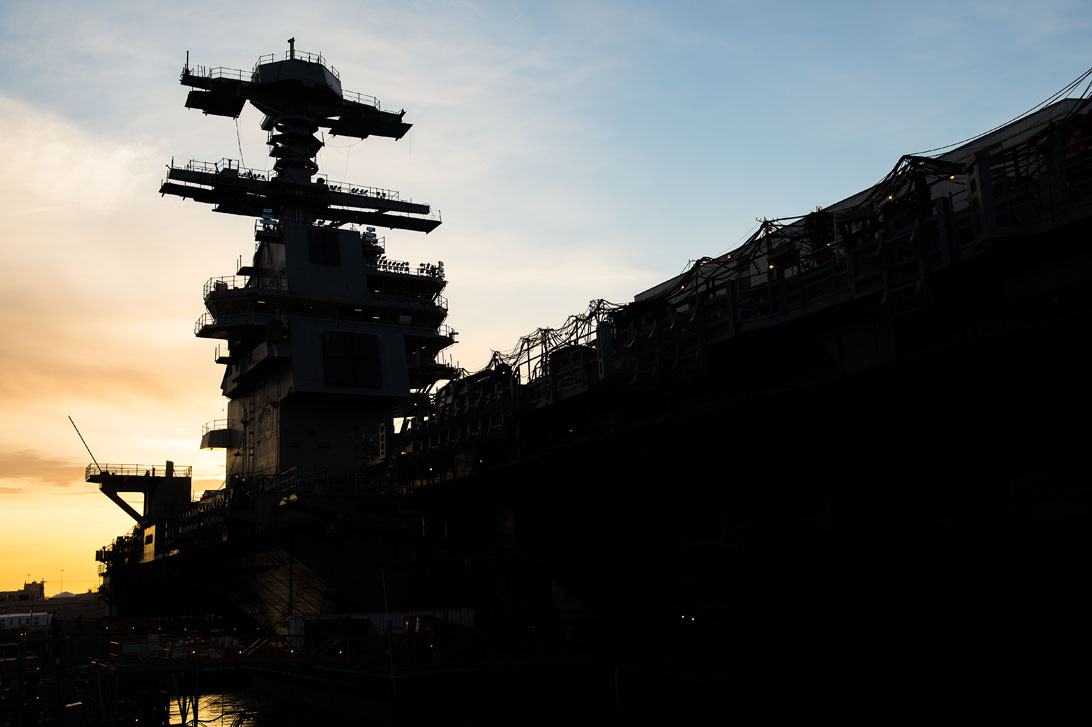
WASHINGTON, D.C. — The aircraft carrier USS John F. Kennedy (CVN-79) will have a different radar than the USS Gerald R. Ford (CVN-78), bringing the new Enterprise Air Surveillance Radar (EASR) into the carrier fleet one ship earlier than planned and saving the program about $180 million, according to the Navy.
Program Executive Officer for Aircraft Carriers Rear Adm. Tom Moore said the new EASR was meant to enter the fleet in the amphibious assault ship LHA-8 and in USS Enterprise (CVN-80), but a series of events made the early introduction possible.
Ford has the Dual Band Radar (DBR) originally built for the truncated Zumwalt (DDG-1000) class of guided missile destroyer. When the Navy planned to build 27 destroyers, the cost of the DBR would have dropped sufficiently to make it a good fit for the carriers. But without that economy of scale, the carrier program had decided to seek a new radar for CVN-80 and beyond.
“I already have to procure a new radar for 80,” Moore told USNI News after a presentation at the Credit Suisse/McAleese 2016 Defense Programs Conference.
“80 is delivering in 2027. CVN-79, which really is not going to become operational until Nimitz (CVN-68) leaves in 2025, is such a short gap, so I went back to the warfare systems guys and said, hey, the radar that we’re looking at for 80 … is there an opportunity to pull that back a little bit to the left and make it available for CVN-79? As it turned out, LHA-8 needed a radar anyway, and the Pentagon had an ongoing effort called basically the Common Affordable Radar – if you want it to be affordable it’s got to be common – so both N98 and N95 and N96, the three resource sponsors, got together with the [Navy acquisition chief Sean Stackley’s] office and said, hey, let’s put a series of requirements together for a radar that would meet the needs of both the aircraft carrier and the big deck amphib.
“We had this working group, they came back to us probably late last summer and said it’s possible,” he continued.
“There are off-the-shelf systems, it’s not developmental, that will meet these requirements.”
Moore said the Program Executive Office for Integrated Warfare Systems would release a request for proposals (RfP) around May, with bids due back in late summer.
“We already know there are radars out there that meet the technical specs that we need, so introducing some competition here will drive cost down,” Moore said.
Whatever radar PEO IWS selects will be less capable than the DBR, which Moore said is fine – “a $500 million radar on an aircraft carrier is overkill at this point,” he said of DBR.
The radar selected for the carriers and amphibs will likely only have volume search capability and need a fire control complement to go with it. Moore said the Navy may use a SPQ-9 fire control system or something comparable.
He also noted that the Nimitz-class carriers’ AN/SPS-48 and AN-SPS-49 radars were becoming obsolete and could be replaced by the new EASR, meaning the new radar would fill three ship class’s requirements.
“From what PEO IWS tells me, it’s a very low technical-risk solution,” Moore said.
“I suspect it will be a robust competition”
The ability to bring in this new radar one ship early – creating a one-time savings of about $180 million, Moore said – was primarily due to the Navy’s decision to switch Kennedy’s construction schedule to a two-phased delivery.
“That gave me a little extra time. If I had to deliver CVN-79 in 2022 when it was originally designed, it wouldn’t have had the radar on it,” Moore said.
“The two-phased strategy gives me the lowest possible cost for the ship, and the radar is a big piece of that.”





